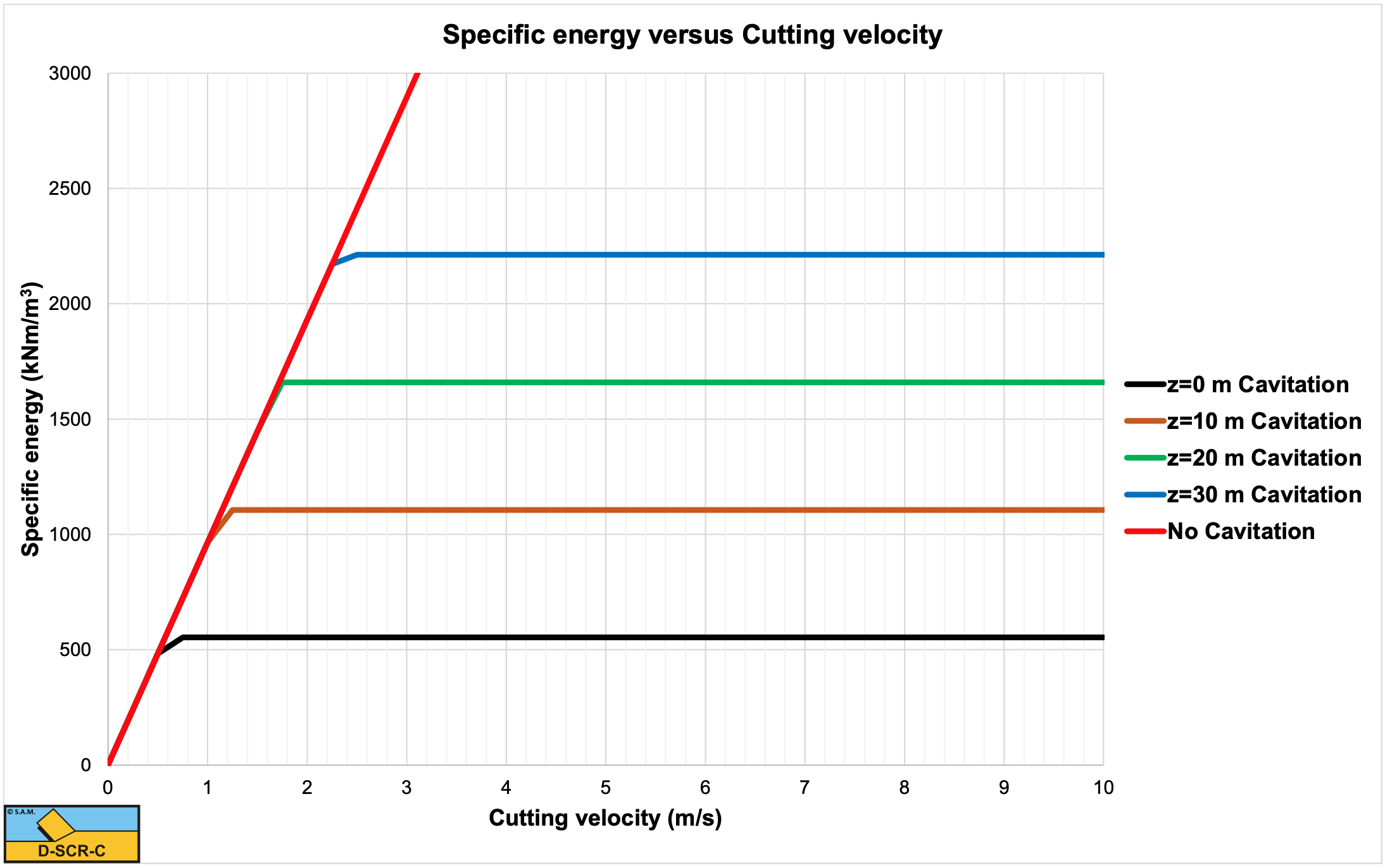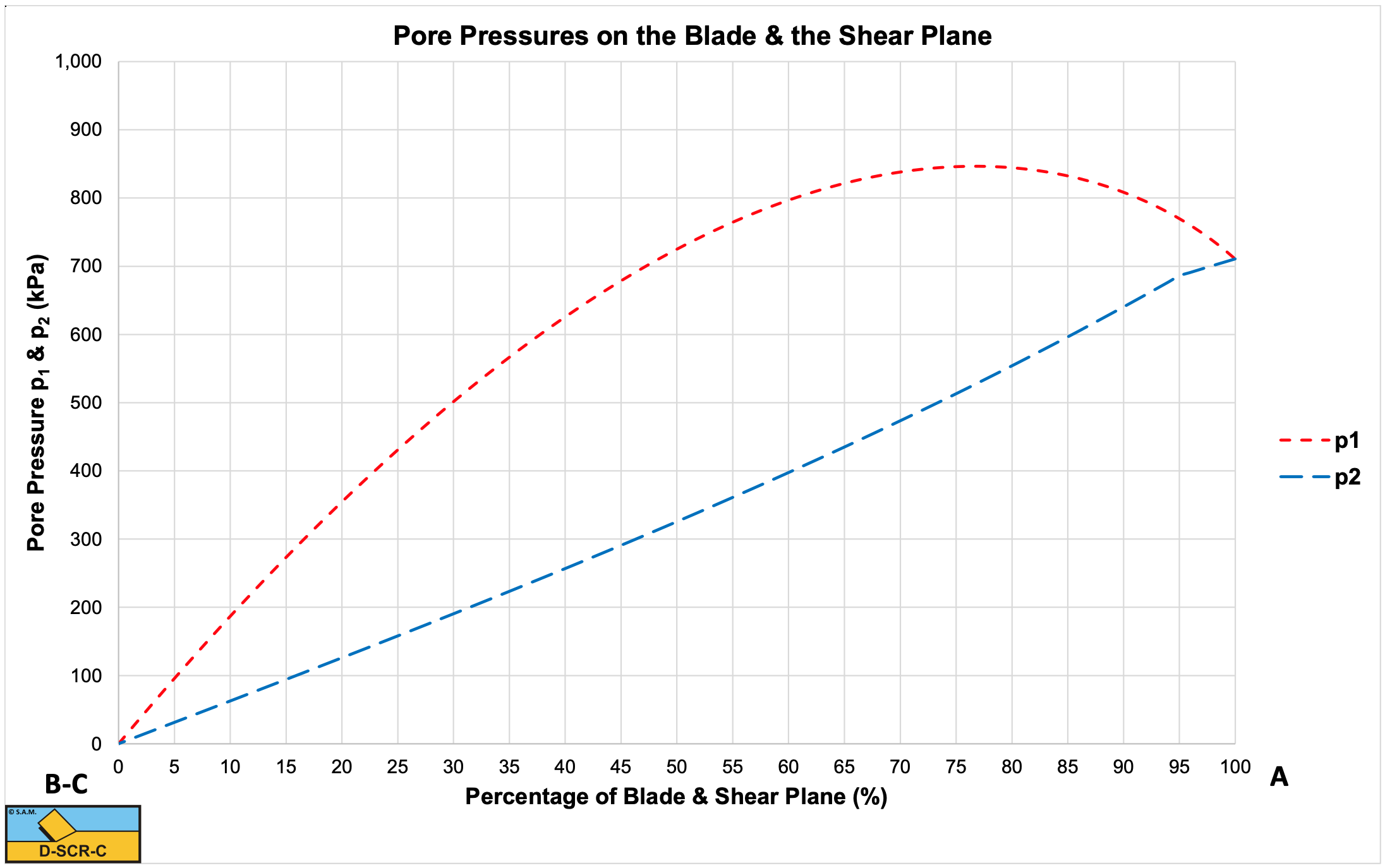16.6: Chapter 6- Water Saturated Sand Cutting
- Page ID
- 29392
16.6.1. MC: Soil Mechanical Parameters
Which of the following soil mechanical parameters play a dominant role in the cutting of saturated sand?
The bold green answers are true.
-
The density of water.
-
The angle of internal friction.
-
The permeability of the sand.
-
The tensile strength of the sand.
-
The porosity of the sand.
-
The adhesion of the sand.
-
The angle of external friction of the sand.
-
The shear strength of the sand.
16.6.2. MC: Dilatation
What is the definition of dilatation?
The bold green answers are true.
-
Dilatation is the increase of the pore volume of sand caused by gravitation.
-
Dilatation is the decrease of the pore volume of sand caused by shear stress.
-
Dilatation is the decrease of the pore volume of sand caused by dredging.
-
Dilatation is the increase of the pore volume of sand caused by shear stress.
-
Dilatation is the increase of the pore volume of sand caused by dredging.
-
Dilatation is the decrease of the pore volume of sand caused by gravitation.
16.6.3. MC: Cavitation
Which statements are true?
The bold green answers are true.
-
Cavitation is in fact the boiling of water.
-
Cavitation at 10 degrees centigrade occurs at about 0.1 bar absolute pressure.
-
At 100 degrees centigrade cavitation will occur at about 100 kPa.
-
Cavitation is the vaporization of water.
-
Cavitation at 10 degrees centigrade occurs at about 0.01 bar absolute pressure.
-
High in the mountains cavitation will occur at a temperature lower than 100 degrees centigrade.
-
At an atmospheric pressure of 100 kPa cavitation occurs at 10 degrees centigrade.
-
High in the mountains cavitation will occur at a temperature higher than 100 degrees centigrade.
16.6.4. Calc.: Porosity
If the porosity of sand is 42% before cutting (in situ) and 50% after cutting, what is the volume increase of the sand (grains + pores) as a fraction?
\(\ \varepsilon=\frac{\mathrm{n}_{\max }-\mathrm{n}_{\mathrm{i}}}{\mathrm{1}-\mathrm{n}_{\max }}=\frac{\mathrm{0 .5}-\mathrm{0 . 4 2}}{\mathrm{1 - 0 .5}}=\mathrm{0 .1 6}\)
16.6.5. Calc. : Density
Assume a water density of 1.000 ton/m3 and a quarts density of 2.650 ton/m3 . What is the density of a sand with a porosity of 40% (saturated sand)?
\(\ \rho_{\mathrm{s}}=(1-\mathrm{n}) \cdot \rho_{\mathrm{q}}+\mathrm{n} \cdot \rho_{\mathrm{w}}=(1-\mathrm{0 .4}) \cdot \mathrm{2 .6 5}+\mathrm{0 .4} \cdot \mathrm{1 . 0 0}=\mathrm{1 .9 9}\quad (\mathrm{ton/m^3})\)
16.6.6. Calc.: Permeability
What is the value of the mean permeability km as used in the cutting equations for water saturated sand? Consider a sand with the following properties:
Initial permeability: ki=0.0001 m/sec
Maximum permeability: kmax=0.0004 m/sec
\(\ \mathrm{k}_{\mathrm{m}}=\frac{\mathrm{k}_{\mathrm{i}}+\mathrm{k}_{\mathrm{max}}}{2}=\frac{\mathrm{0 . 0 0 0 1 + 0 . 0 0 0 4}}{2}=\mathrm{0 .0 0 0 2 5} \quad(\mathrm{m} / \mathrm{sec})\)
16.6.7. Calc.: Dilatancy
What is the value of the dilatancy ε?
Consider a sand with the following properties:
initial porosity: ni=40%
Maximum porosity: nmax=50%
\(\ \varepsilon=\frac{\mathrm{n}_{\mathrm{max}}-\mathrm{n}_{\mathrm{i}}}{1-\mathrm{n}_{\mathrm{max}}}=\frac{\mathrm{0 .5 - 0 .4}}{\mathrm{1 - 0 .5}}=\mathrm{0 .2 0}\quad (-)\)
16.6.8. Calc.: Transition Velocity
Give the equation for the transition velocity from non-cavitating cutting to cavitating cutting.
\(\ \mathrm{v}_{\mathrm{c}}=\frac{\mathrm{d}_{1} \cdot(\mathrm{z}+\mathrm{1} \mathrm{0}) \cdot \mathrm{k}_{\mathrm{m}}}{\mathrm{c}_{\mathrm{1}} \cdot \mathrm{h}_{\mathrm{i}} \cdot \mathrm{\varepsilon}}\)
16.6.9. Calc.: Cutting Forces & Specific Energy
Consider a sand with the following properties:
Angle of internal friction: φ=36o
Angle of external friction: δ=24o
Initial permeability: ki=0.00005 m/sec
Maximum permeability: kmax=0.00025 m/sec
initial porosity: ni=42%
Maximum porosity: nmax=50%
The cutting blade has the following properties:
The cutting angle: α=60o
The shear angle: β=20o
The blade height: hb=0.2 m
The thickness of the layer to be cut: hi=0.1 m
The width of the blade: w=1 m
Coefficients for the cutting equations:
The coefficient for non-cavitating cutting: c1=0.35
The coefficient for cavitating cutting: d1=4.5
General constants:
The density of water: ρw=1.025 tons/m3
The gravitational constant: g=9.81 m/sec2
A: What are the horizontal cutting forces at 0 m, 15 m and 30 m water depth for the non-cavitational cutting process at a cutting velocity of 0.5 m/s?
\(\ \begin{array}{left} \mathrm{F}_{\mathrm{h}} &=\frac{\mathrm{c}_{1} \cdot \rho_{\mathrm{w}} \cdot \mathrm{g} \cdot \mathrm{v}_{\mathrm{c}} \cdot \mathrm{h}_{\mathrm{i}}^{2} \cdot \varepsilon \cdot \mathrm{w}}{\mathrm{k}_{\mathrm{m}}}=\frac{\mathrm{0 .3 5} \cdot \mathrm{1 .0 2 5} \cdot \mathrm{9 .8 1 \cdot 0 .} \mathrm{1}^{2} \cdot \mathrm{0 .1 6} \cdot \mathrm{1}}{\mathrm{0 .0 0 0 1 5}} \cdot \mathrm{v}_{\mathrm{c}} \\ &=\mathrm{3 7 .5 4} \cdot \mathrm{v}_{\mathrm{c}}=\mathrm{3 7 .5 4} \cdot \mathrm{0 .5}=\mathrm{1 8 .7 7} \end{array}\quad(\mathrm{kN})\)
The non-cavitational force does not depend on the water depth.
B: What are the horizontal cutting forces at 0 m, 15 m and 30 m water depths for the cavitational cutting process?
\(\ \begin{array}{left} \mathrm{F}_{\mathrm{h}} &=\mathrm{d}_{1} \cdot \rho_{\mathrm{w}} \cdot \mathrm{g} \cdot(\mathrm{z}+\mathrm{1 0}) \cdot \mathrm{h}_{\mathrm{i}} \cdot \mathrm{w}=\mathrm{4 .5} \cdot \mathrm{1 .0 2 5} \cdot \mathrm{9 .8 1} \cdot \mathrm{0 .1} \cdot \mathrm{1} \cdot(\mathrm{z}+\mathrm{1 0}) \\ &=\mathrm{4 .5 2} \cdot(\mathrm{z}+\mathrm{1 0}) \end{array}\quad(\mathrm{kN})\)
This gives for 0 m water depth a force of 45.2 kN, for 15 m water depth a force of 113 kN and for 30 m water depth a force of 180.8 kN.
C: At which velocities are the transitions between the cavitational and the non-cavitational cutting process at 0 m, 15 m and 30 m water depths?
\(\ \mathrm{37.54 \cdot v_{c}=4.52 \cdot(z+10) \quad\Rightarrow \quad v_{c}=0.12 \cdot(z+10)\quad(m / s e c)}\)
This gives for 0 m water depth a transition velocity of 1.2 m/sec, for 15 m water depth a transition velocity of 3.0 m/sec and for 30 m water depth a transition velocity of 4.8 m/sec.
D: What is the specific energy at 0 m, 15 m and 30 m water depth at a cutting velocity of 1 m/s?
\(\ \mathrm{\mathrm{E}_{\mathrm{sp}}=\frac{\mathrm{F}_{\mathrm{h}} \cdot \mathrm{v}_{\mathrm{c}}}{\mathrm{h}_{\mathrm{i}} \cdot \mathrm{w} \cdot \mathrm{v}_{\mathrm{c}}}=\frac{\mathrm{F}_{\mathrm{h}}}{\mathrm{h}_{\mathrm{i}} \cdot \mathrm{w}}=\frac{\mathrm{F}_{\mathrm{h}}}{\mathrm{0 . 1} \cdot \mathrm{1}}=\mathrm{1 0} \cdot \mathrm{F}_{\mathrm{h}}}\quad (\mathrm{kPa})\)
At a cutting velocity of 1 m/sec the cutting process is non-cavitational at all 3 water depths, so in all 3 cases the specific energy is 375.4 kPa.
E: What is the specific energy at a water depth of 0 m, 15 m and 30 m at a cutting velocity of 2 m/s?
At a cutting velocity of 2 m/sec, the cutting process at 0 m water depth is cavitating, giving a specific energy of 452 kPa. At a water depth of 15 m the cutting process is non-cavitational giving a specific energy of 750.8 kPa. At a water depth of 30 m the cutting process is also non-cavitational giving a specific energy of 750.8 kPa.
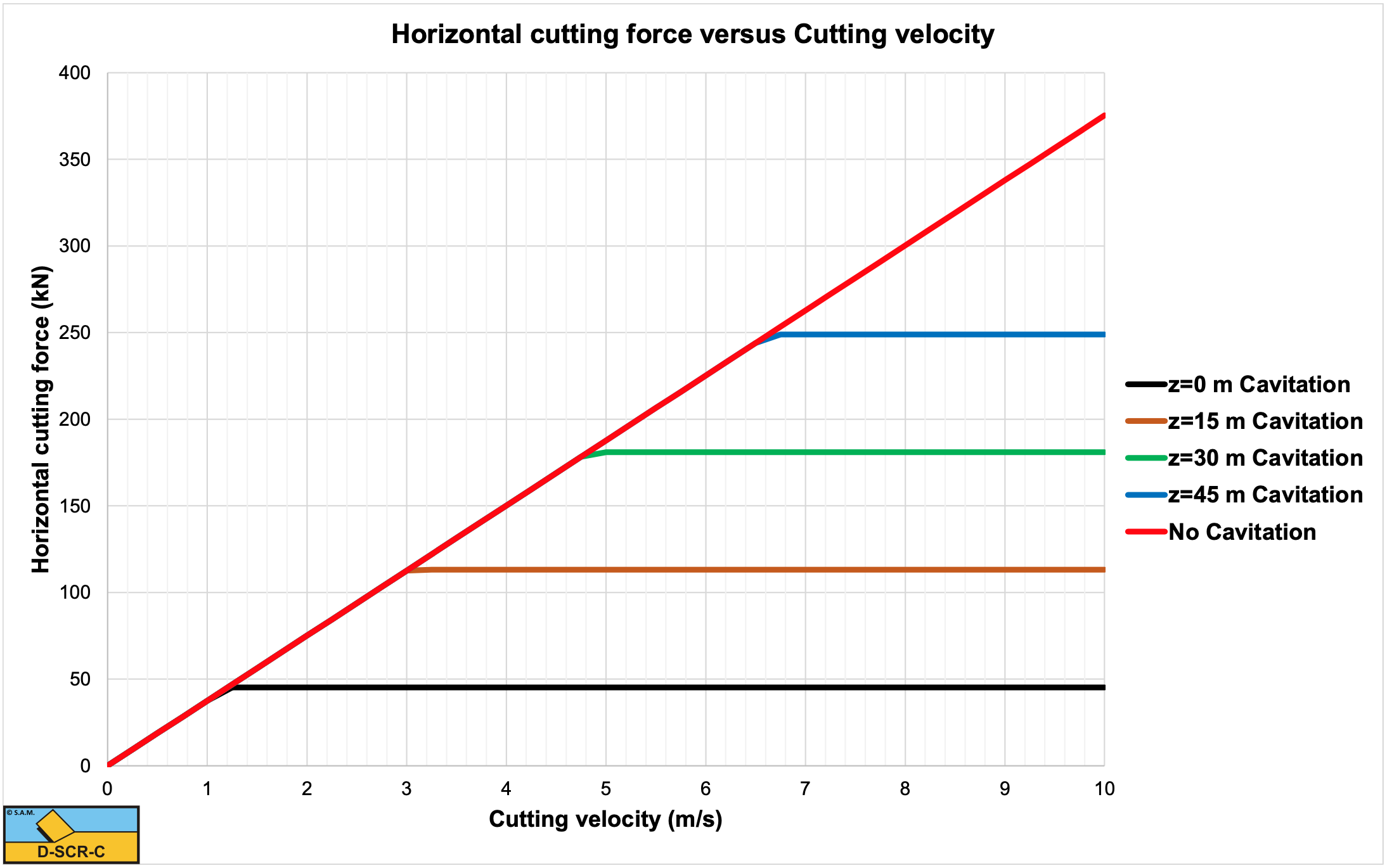
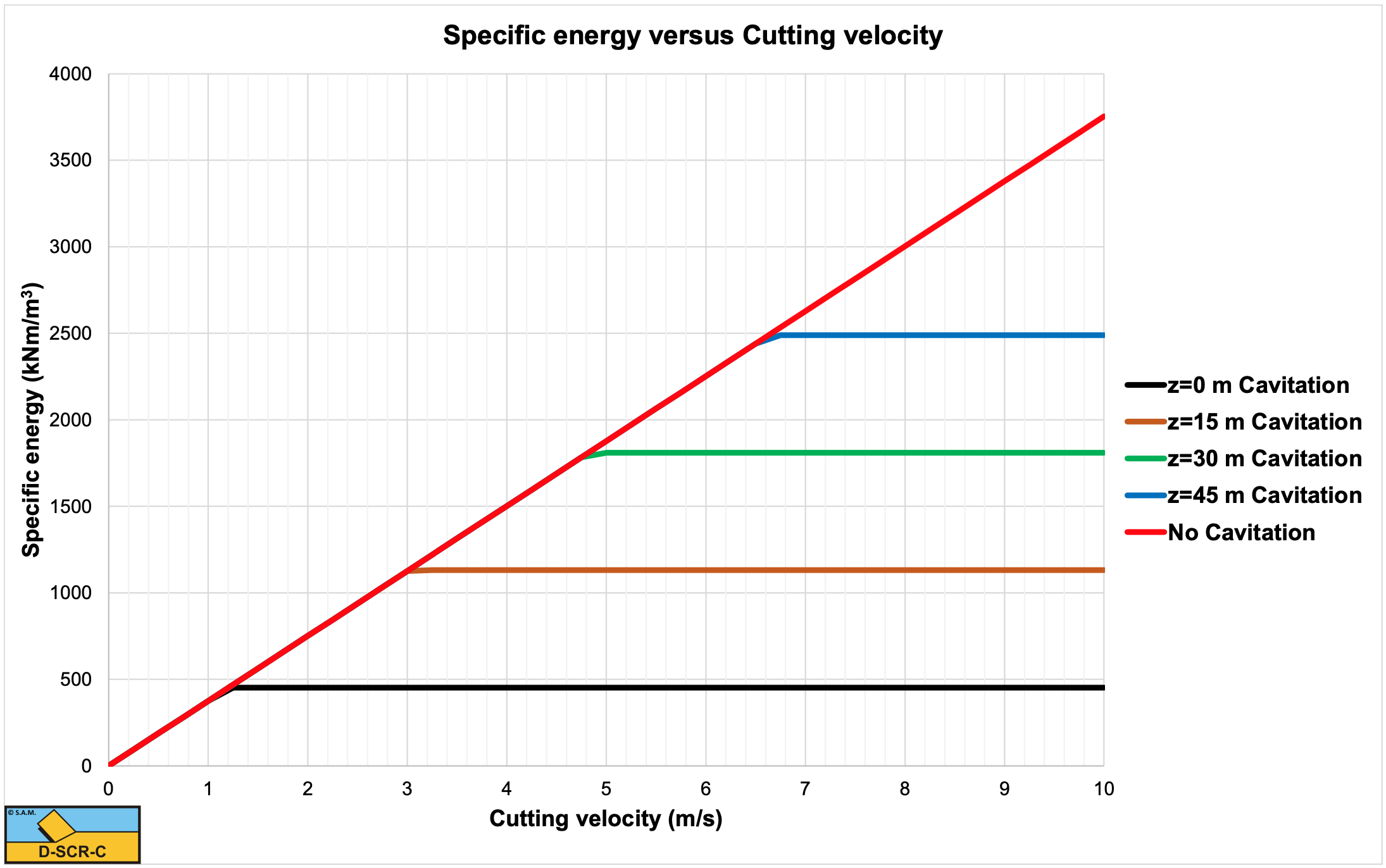
F: Determine the pore pressure at the centre of the shear plane using the parallel resistor method for a cutting velocity of 0.5 m/sec.
First the 4 lengths have to be determined:
\(\ \begin{array}{left} \mathrm{s_{1}=\left(L_{\max }-L\right) \cdot\left(\frac{\pi}{2}+\frac{\pi}{2}-(\alpha+\beta)\right)+\frac{h_{b}}{\sin (\alpha)}=0.486}\\
\mathrm{s_{2}=0.8 \cdot L \cdot(\alpha+\beta)=0.163}\\
\mathrm{s_{3}=0.8 \cdot L \cdot(\pi-\beta)=0.327}\\
\mathrm{s_{4}=\left(L_{\max }-L\right) \cdot(\pi+\beta)+0.9 \cdot h_{\mathrm{i}} \cdot\left(\frac{h_{\mathrm{i}}}{h_{\mathrm{b}}}\right)^{0.5} \cdot(1.85 \cdot \alpha)^{2} \cdot\left(\frac{\mathrm{k}_{\mathrm{i}}}{\mathrm{k}_{\mathrm{max}}}\right)^{0.4}=0.636}\end{array}\)
Secondly the total resistance has to be determined:
\(\ \mathrm{\frac{1}{R_{t}}=\left(\frac{s_{1}}{k_{\max }}\right)+\left(\frac{s_{2}}{k_{\max }}\right)+\left(\frac{s_{3}}{k_{i}}\right)+\left(\frac{s_{4}}{k_{i}}\right) \Rightarrow R_{t}=439}\)
\(\ \mathrm{\Delta \mathrm{p}=\rho_{\mathrm{w}} \cdot \mathrm{g} \cdot \varepsilon \cdot \mathrm{v}_{\mathrm{c}} \cdot \sin (\beta) \cdot \mathrm{R}_{\mathrm{t}}=120.8(\mathrm{k} \mathrm{P} \mathrm{a})}\)
Below which water depth will we have cavitation at this point?
An absolute pressure of 120.8 kPa is reached at a water depth of 2.07 m, so the point on the shear plane considered will cavitated for water depths below 2.07 m.
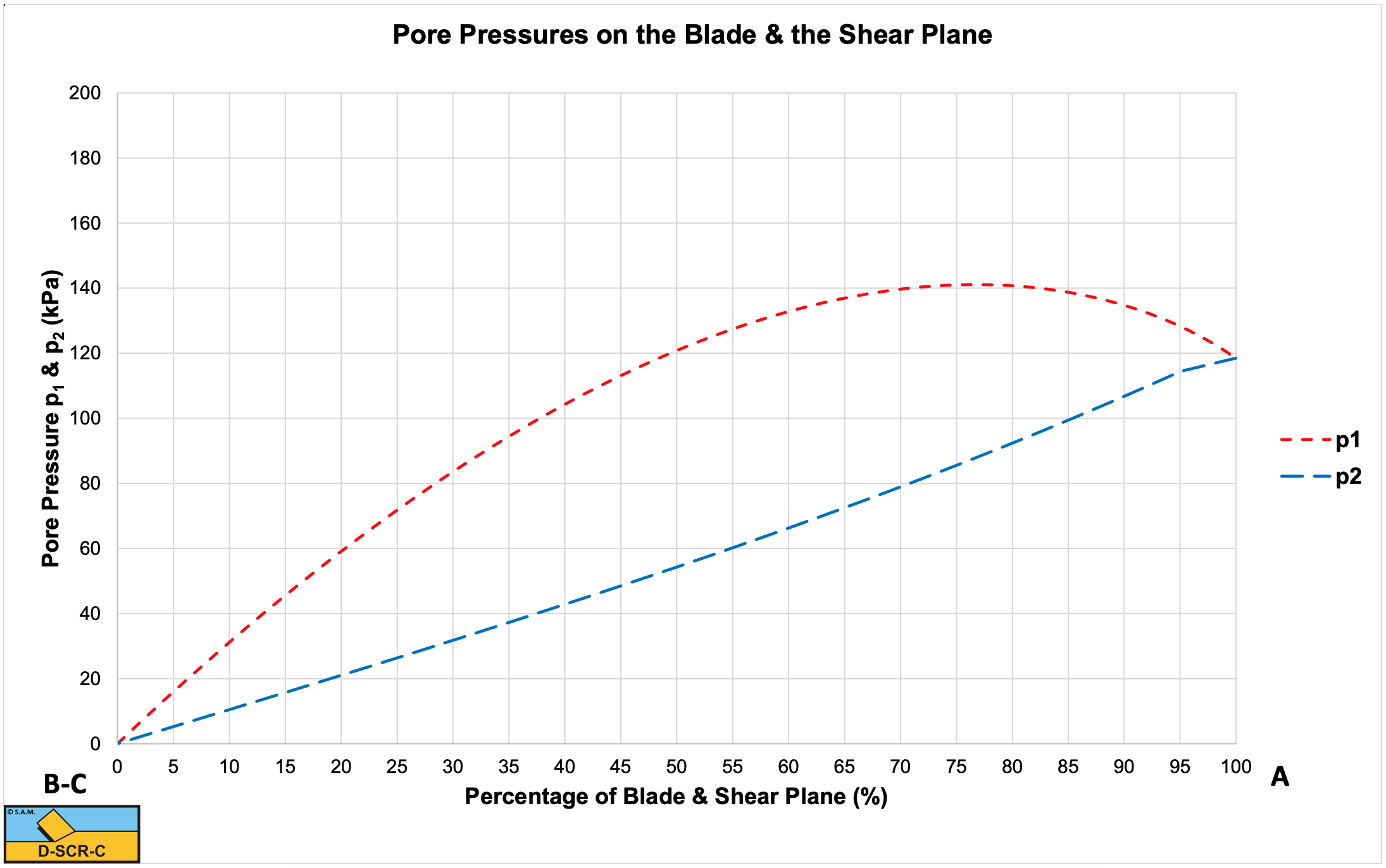
16.6.10. Calc.: Cutting Forces & Specific Energy
Consider a sand with the following properties:
Angle of internal friction: φ=36o
Angle of external friction: δ=24o
Initial permeability: ki=0.000025 m/sec
Maximum permeability: kmax=0.000125 m/sec
initial porosity: ni=42%
Maximum porosity: nmax=50%
The cutting blade has the following properties:
The cutting angle: α=60o
The shear angle: β=20o
The blade height: hb=0.2 m
The thickness of the layer to be cut: hi=0.1 m
The width of the blade: w=1 m
Coefficients for the cutting equations:
The coefficient for non-cavitating cutting: c1=0.45
The coefficient for cavitating cutting: d1=5.5
General constants:
The density of water: ρw=1.025 tons/m3
The gravitational constant: g=9.81 m/sec2
A: What are the horizontal cutting forces at 0 m, 10 m and 20 m water depth for the non-cavitational cutting process at a cutting velocity of 1.5 m/s?
\(\ \begin{array}{left} \mathrm{F}_{\mathrm{h}} &=\frac{\mathrm{c}_{\mathrm{1}} \cdot \mathrm{\rho}_{\mathrm{w}} \cdot \mathrm{g} \cdot \mathrm{v}_{\mathrm{c}} \cdot \mathrm{h}_{\mathrm{i}}^{2} \cdot \mathrm{\varepsilon} \cdot \mathrm{w}}{\mathrm{k}_{\mathrm{m}}}=\frac{\mathrm{0} . \mathrm{45} \cdot \mathrm{1 . 0 2 5} \cdot \mathrm{9 .8 1} \cdot \mathrm{0 . 1}^{2} \cdot \mathrm{0 . 1 6} \cdot \mathrm{1}}{\mathrm{0.} \mathrm{0 0 0 0 7 5}} \cdot \mathrm{v}_{\mathrm{c}} \\ &=\mathrm{96 .5 3} \cdot \mathrm{v}_{\mathrm{c}}=\mathrm{9 6 .5 3} \cdot \mathrm{1 .5}=\mathrm{1 4 4 .8} \end{array}\quad(\mathrm{kN})\)
The non-cavitational force does not depend on the water depth.
B: What are the horizontal cutting forces at 0 m, 10 m and 20 m water depths for the cavitational cutting process?
\(\ \begin{array}{left} \mathrm{F}_{\mathrm{h}} &=\mathrm{d}_{1} \cdot \rho_{\mathrm{w}} \cdot \mathrm{g} \cdot(\mathrm{z}+\mathrm{1 0}) \cdot \mathrm{h}_{\mathrm{i}} \cdot \mathrm{w}=\mathrm{5.5} \cdot \mathrm{1 .0 2 5} \cdot \mathrm{9 .8 1} \cdot \mathrm{0 .1} \cdot \mathrm{1} \cdot(\mathrm{z}+\mathrm{1 0}) \\ &=\mathrm{5 .5 3} \cdot(\mathrm{z}+\mathrm{1 0}) \end{array}\quad (\mathrm{kN})\)
This gives for 0 m water depth a force of 55.3 kN, for 10 m water depth a force of 110.6 kN and for 20 m water depth a force of 165.9 kN.
C: At which velocities are the transitions between the cavitational and the non-cavitational cutting process at 0 m, 10 m and 20 m water depths?
\(\ \mathrm{96.53\cdot v_c = 5.53 \cdot (z+10) \quad\Rightarrow \quad v_{c}=0.0573 \cdot(z+10)(m / s e c)}\)
This gives for 0 m water depth a transition velocity of 0.573 m/sec, for 10 m water depth a transition velocity of 1.146 m/sec and for 20 m water depth a transition velocity of 1.719 m/sec.
D: What is the specific energy at 0 m, 10 m and 20 m water depth at a cutting velocity of 1 m/s?
\(\ \mathrm{E}_{\mathrm{sp}}=\frac{\mathrm{F}_{\mathrm{h}} \cdot \mathrm{v}_{\mathrm{c}}}{\mathrm{h}_{\mathrm{i}} \cdot \mathrm{w} \cdot \mathrm{v}_{\mathrm{c}}}=\frac{\mathrm{F}_{\mathrm{h}}}{\mathrm{h}_{\mathrm{i}} \cdot \mathrm{w}}=\frac{\mathrm{F}_{\mathrm{h}}}{\mathrm{0 .1} \cdot \mathrm{1}}=\mathrm{1 0} \cdot \mathrm{F}_{\mathrm{h}} \quad (\mathrm{kPa})\)
At a cutting velocity of 1 m/sec the cutting process is non-cavitational at all z=0 m and non-cavitational at z=10 m and z=20 m, so in the specific energy is 553 kPa at z=0 m and 965.3 kPa at z=10 m and z=20 m.
E: What is the specific energy at a water depth of 0 m, 10 m and 20 m at a cutting velocity of 2 m/s?
At a cutting velocity of 2 m/sec, the cutting process at 0 m water depth is cavitating, giving a specific energy of 553 kPa. At a water depth of 10 m the cutting process is cavitational giving a specific energy of 1106 kPa. At a water depth of 20 m the cutting process is also cavitational giving a specific energy of 1659 kPa.
F: Determine the pore pressure at the centre of the shear plane using the parallel resistor method for a cutting velocity of 1.5 m/sec.
First the 4 lengths have to be determined:
\(\ \begin{array}{left}\mathrm{s}_{1}=\left(\mathrm{L}_{\max }-\mathrm{L}\right) \cdot\left(\frac{\pi}{2}+\frac{\pi}{2}-(\alpha+\beta)\right)+\frac{\mathrm{h}_{\mathrm{b}}}{\sin (\alpha)}=\mathrm{0 .4 8 6}\\
\mathrm{s_{2}=0.8 \cdot L \cdot(\alpha+\beta)=0.163}\\
\mathrm{s_{3}=0.8 \cdot L \cdot(\pi-\beta)=0.327}\\
\mathrm{s_{4}=\left(L_{\max }-L\right) \cdot(\pi+\beta)+0.9 \cdot h_{\mathrm{i}} \cdot\left(\frac{h_{\mathrm{i}}}{h_{\mathrm{b}}}\right)^{0.5} \cdot(1.85 \cdot \alpha)^{2} \cdot\left(\frac{\mathrm{k}_{\mathrm{i}}}{k_{\max }}\right)^{0.4}=0.636}\end{array}\)
Secondly the total resistance has to be determined:
\(\ \mathrm{\frac{1}{\mathrm{R}_{t}}=\left(\frac{s_{1}}{k_{\max }}\right)+\left(\frac{s_{2}}{k_{\max }}\right)+\left(\frac{s_{3}}{k_{i}}\right)+\left(\frac{s_{4}}{k_{i}}\right) \Rightarrow R_{t}=878}\)
\(\ \Delta \mathrm{p}=\rho_{\mathrm{w}} \cdot \mathrm{g} \cdot \varepsilon \cdot \mathrm{v}_{\mathrm{c}} \cdot \sin (\beta) \cdot \mathrm{R}_{\mathrm{t}}=72 \mathrm{5}(\mathrm{k} \mathrm{P} \mathrm{a})\)
Below which water depth will we have cavitation at this point?
An absolute hydrostatic pressure of 725 kPa is reached at a water depth of 62.15 m, so the point on the shear plane considered will cavitated for water depths below 62.15 m.

